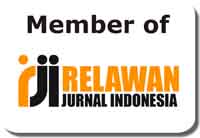Femininity and Masculinity in Arabic Words: Gender Marking in Muslim Cosmology
Abstract
Keywords
Full Text:
PDFReferences
Abidin, Z. (2015). Wahabisme, Transnasionalisme dan gerakan-gerakan radikal Islam di Indonesia [Wahhabism, Transnationalism and Islamic radical movements in Indonesia]. Tasamuh, 12(2), 130–148.
Abu-Ayyash, E.A.S. (2017). Errors and non-errors in English–Arabic machine translation of gender-bound constructs in technical texts. Procedia Computer Science, 117, 73–80. doi: 10.1016/j.procs.2017.10.095.
Al-Ghadir, A.I., & Azmi, A.M. (2019). A study of Arabic social media users—posting behavior and author's gender prediction. Cognitive Computation, 11(1), 71–86. doi: 10.1007/s12559-018-9592-7.
Al-Harahsheh, A.M.A. (2014). Language and gender differences in Jordanian-spoken Arabic: a sociolinguistics perspective. Theory and Practice in Language Studies, 4(5), 872. doi:10.4304/tpls.4.5.872-882.
Al-Qatawneh, S., & Al Rawashdeh, A. (2019). Gender representation in the Arabic language textbook for the ninth grade approved by the Ministry of Education for use in schools in the United Arab Emirates (UAE). Studies in Educational Evaluation, 60, 90–98. doi: 10.1016/j.stueduc.2018.12.001.
Al-Qatawneh, S., & Al Rawashdeh, A. (2019). Gender representation in the Arabic language textbook for the ninth grade approved by the Ministry of Education for use in schools in the United Arab Emirates (UAE). Studies in Educational Evaluation, 60, 90–98.
Al-Quzwaini. (1993). Al-Idloh fi Ulum il-Balaghah, Beirut: Dar al-Jail.
Alhassan, Salifu Nantogma. (2014). Sexism and gender stereotyping in the Dagbanli language. Gender and Language, 8(3) 393-415
Alsmearat, K., Al-Ayyoub, M., Al-Shalabi, R., & Kanaan, G. (2017). Author gender identification from Arabic text. Journal of Information Security and Applications, 35, 85–95. doi: 10.1016/j.jisa.2017.06.003
Azong, M. N., & Kelso, C. J. (2021). Gender, ethnicity and vulnerability to climate change: The case of matrilineal and patrilineal societies in Bamenda Highlands Region, Cameroon. Global Environmental Change, 67, 102241. doi: 10.1016/j.gloenvcha.
Bhagavatheeswaran, L., Nair, S., Stone, H., Isac, S., Hiremath, T., Raghavendra, T., et al. (2016). The barriers and enablers to education among scheduled caste and scheduled tribe adolescent girls in northern Karnataka, South India: A qualitative study. International Journal of Educational Development, 49, 262–270.
Bogetić, K. (2013). Normal straight gays: Lexical collocations and ideologies of masculinity in personal ads of Serbian gay teenagers, 7(3), 333-367
Bolukbasi, T., Chang, K.W., Zou, J.Y., Saligrama, V., & Kalai, A.T. (2016). Man is to computer programmer as woman is to homemaker? Debiasing word embeddings. In Advances in Neural Information Processing Systems (pp. 4349–4357).
Branisa, B., Klasen, S., & Ziegler, M. (2013). Gender inequality in social institutions and gendered development outcomes. World Development, 45, 252–268. doi: 10.1016/j.worlddev.2012.12.003
Cameron, D. (2014). 14 gender and language ideologies. In The Handbook of Language, Gender, and Sexuality, 281.
Carli, L.L. (1990). Gender, language, and influence. Journal of Personality and Social Psychology, 59(5), 941.
Chang, Q., Yip, P.S., & Chen, Y.Y. (2019). Gender inequality and suicide gender ratios in the world. Journal of Affective Disorders, 243, 297–304.
Coady, Ann. (2018). The Origin of Sexism in Language. Gender and Language 12(3), 271-293.
Coffey-Glover, L. (2015). Ideologies of masculinity in women’s magazines: a critical stylistic approach. Gender and Language, 9(3), 337-364.
De Looze, M., Elgar, F.J., Currie, C., Kolip, P., & Stevens, G. W. (2019). Gender inequality and sex differences in physical fighting, physical activity, and injury among adolescents across 36 countries. Journal of Adolescent Health, 64(5), 657–663. doi: 10.1016/j.jadohealth.2018.11.007
Deogracias, J.J., Johnson, L.L., Meyer-Bahlburg, H.F., Kessler, S.J., Schober, J.M., & Zucker, K.J. (2007). The gender identity/gender dysphoria questionnaire for adolescents and adults. Journal of Sex Research, 44(4), 370–379.
Determann, J.M. (2013). Historiography in Saudi Arabia: globalization and the state in the Middle East, 42. IB Tauris.
Eckert, P., & McConnell-Ginet, S. (1999). New generalizations and explanations in language and gender research. Language in Society, 28(2), 185–201.
Flotskaya, N., Bulanova, S., Ponomareva, M., Flotskiy, N., & Konopleva, T. (2018). Gender identity development among teenagers living in the subarctic region of Russia. Behavioral Sciences, 8(10), 90. doi: 10.3390/bs8100090.
Garcia Coll, C., Garcia Miranda, A., Buzzetta Torres, I., & Nogueras Bermúdez, J. (2018). On becoming cultural beings: a focus on race, gender, and language. Research in Human Development, 15(3–4), 332–344. doi: 10.1080/15427609.2018.1491217.
Ginsburgh, V., & Prieto-Rodriguez, J. (2013). Is there a gender bias in the use of foreign languages in Europe? Kyklos, 66(4), 552–566. doi: 10.1111/kykl.12035.
Gormley, S. (2015). Language and gender. In International Encyclopaedia of Social & Behavioral Sciences (second edition). doi: 10.1016/B978-0-08-097086-8.53055-4.
Hamdan, J.M., & Natour, Y.S. (2014). Gender of cited authors: A problem for the English–Arabic translation of scholarly research. Babel, 60(3), 265–280. doi: 10.1075/babel.60.3.01ham.
Hamidi, O., & Nippoldt, T. B. (2019). Biology of gender identity and gender incongruence. In Transgender Medicine (pp. 39–50). Humana Press, Cham.
Huffaker, D.A., & Calvert, S.L. (2005). Gender, identity, and language use in teenage blogs. Journal of Computer-Mediated Communication, 10(2), JCMC10211.
Inglehart, R., Norris, P., & Ronald, I. (2003). Rising tide: gender equality and cultural change around the world. Cambridge University Press.
Jaworska, S., & Ryan, K. (2018). Gender and the language of pain in chronic and terminal illness: A corpus-based discourse analysis of patients' narratives. Social Science & Medicine, 215, 107–114. doi: 10.1016/j.socscimed.2018.09.002.
Korpaisarn, S., & Safer, J.D. (2019). Etiology of gender identity. Endocrinology and Metabolism Clinics, 48(2), 323–329. doi: 10.1016/j.ecl.2019.01.002.
Lekchiri, S., Crowder, C., Schnerre, A., & Eversole, B.A. (2019). Perceived workplace gender-bias and psychological impact: The case of women in a Moroccan higher education institution. European Journal of Training and Development, 43(3/4), 339–353.
Lindqvist, A., Renström, E. A., & Sendén, M. G. (2019). Reducing a male bias in language? Establishing the efficiency of three different gender-fair language strategies. Sex Roles, 81(1–2), 109–117. doi: 10.1007/s11199-018-0974-9.
Lorber, J. 2010. Gender inequality. Oxford University Press.
MacArthur, H.J., Cundiff, J.L., & Mehl, M.R. (2019). Estimating the prevalence of gender-biased language in undergraduates' everyday speech. Sex Roles, 1–13. doi: 10.1007/s11199-019-01033-z.
Menegatti, M., & Rubini, M. (2017). Gender bias and sexism in language. In Oxford Research Encyclopedia of Communication. Oxford University Press.
Mougharbel, G.M., & Bahous, R. (2010). Gender bias in Lebanese language classes. The Educational Forum, 74(3), 198–212. doi: 10.1080/00131725.2010.483901.
Myhill, J. (2015). Religion: nationalism and identity. International Encyclopedia of the Social & Behavioral Sciences, 338–343. doi: 10.1016/b978-0-08-097086-8.84037-4.
Park, J.H., Shin, J., & Fung, P. (2018). Reducing gender bias in abusive language detection. arXiv:1808.07231.
Protivínský, T., & Münich, D. (2018). Gender bias in teachers' grading: what is in the grade. Studies in Educational Evaluation, 59, 141–149. doi: 10.1016/j.stueduc.2018.07.006.
Sadiqi, F. (2006). Gender in Arabic. The Brill Encyclopedia of Linguistics, 2, 642–650.
Schwartz, S.H., & Rubel-Lifschitz, T. (2009). Cross-national variation in the size of sex differences in values: effects of gender equality. Journal of Personality and Social Psychology, 97(1), 171.
Shen, K., et al. 2016. Patterns of inequalities in public transfers by gender in China. The Journal of the Economics of Ageing. doi: 10.1016/j.jeoa.2016.04.005
Singh, R., & Mukherjee, P. (2018). 'Whatever she may study, she can't escape from washing dishes': gender inequity in secondary education–evidence from a longitudinal study in India. Compare: A Journal of Comparative and International Education, 48(2), 262–280.
Smyth, E. (2007). Gender and education. In International Studies in Educational Inequality, Theory and Policy (pp. 135–153). Springer, Dordrecht.
Steensma, T.D., Kreukels, B.P., de Vries, A.L., & Cohen-Kettenis, P.T. (2013). Gender identity development in adolescence. Hormones and Behavior, 64(2), 288–297.
Stubbe, M. (2004). Gender, language and discourse. Women in Management Review, 19(2), 123–125.
Suwardi, S., Anitah, S., Akhyar, M., & Asrowi, A. (2018). Gender bias in Islamic textbooks for Muslim children in Indonesia. Attarbiyah: Journal of Islamic Culture and Education, 2(2), 214–235.
Thelwall, M., Bailey, C., Makita, M., Sud, P., & Madalli, D.P. (2019). Gender and research publishing in India: Uniformly high inequality? Journal of Infometrics, 13(1), 118–131. doi: 10.1016/j.joi.2018.12.003
Trigg, R. (1985). Understanding social science: a philosophical introduction to the social sciences. Oxford: Blackwell.
Wargadinata, W. & Fitriani, L. (2008). Sastra Arab lintas budaya [Cross-cultural Arabic literature]. Malang: UIN Maliki Press.
Weatherall, A. (2016). Sexism in language. In The Wiley Blackwell Encyclopedia of Gender and Sexuality Studies, 1–2.
Wegren, S.K., Nikulin, A., Trotsuk, I., & Golovina, S. (2017). Gender inequality in Russia's rural informal economy. Communist and Post-Communist Studies, 50(2), 87–98. doi: 10.1016/j.postcomstud.2017.05.007.
Wicha, N.Y.Y., Moreno, E.M., and Kutas, M. (2004). Anticipating words and their gender: an event-related brain potential study of semantic integration, gender expectancy, and gender agreement in Spanish sentence reading. Journal of Cognitive Neuroscience, 16, 1272–1288. doi: 10.1162/0898929041920487.
Williams, L. (2019). Language, gender, and voice: empowering Arabic women in the ESL classroom. Unpublished doctoral dissertation, California State University, Northridge.
Zhang, C.X., Fong, L.H.N., Li, S., & Ly, T.P. (2019). National identity and cultural festivals in postcolonial destinations. Tourism Management, 73, 94–104. doi: 10.1016/j.tourman.2019.01.013.
DOI: http://dx.doi.org/10.31332/lkw.v7i2.3130
Copyright (c) 2021 Muassomah Muassomah, Wildana Wargadinata, Galuh Nur Rohmah, Rohmani Nur Indah, Siti Masitoh, Istiadah Istiadah, Irwan Abdullah

This work is licensed under a Creative Commons Attribution-ShareAlike 4.0 International License.
Langkawi: Journal of The Association for Arabic and English indexed by:



















.png)
.png)

.png)
2.png)








